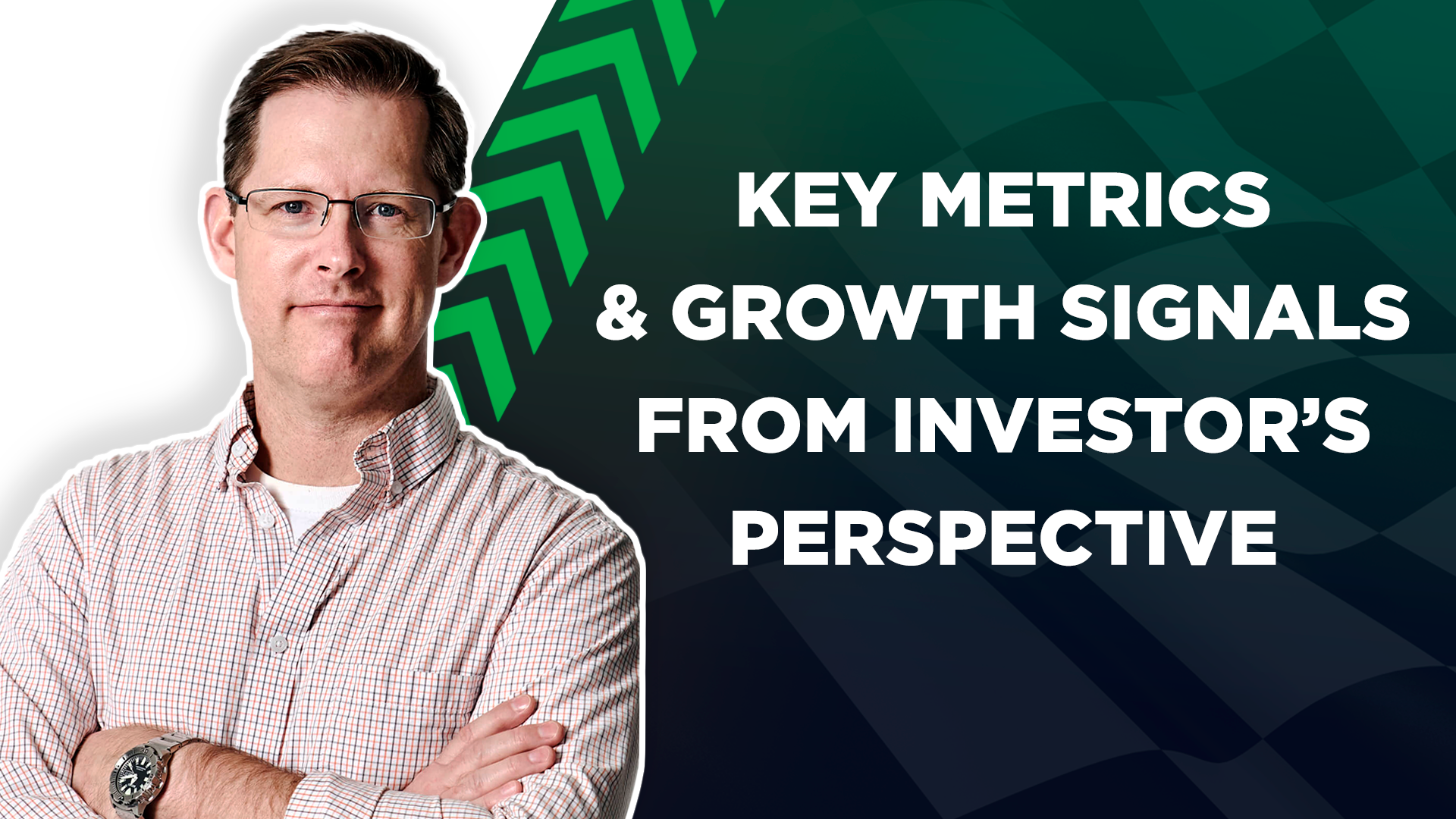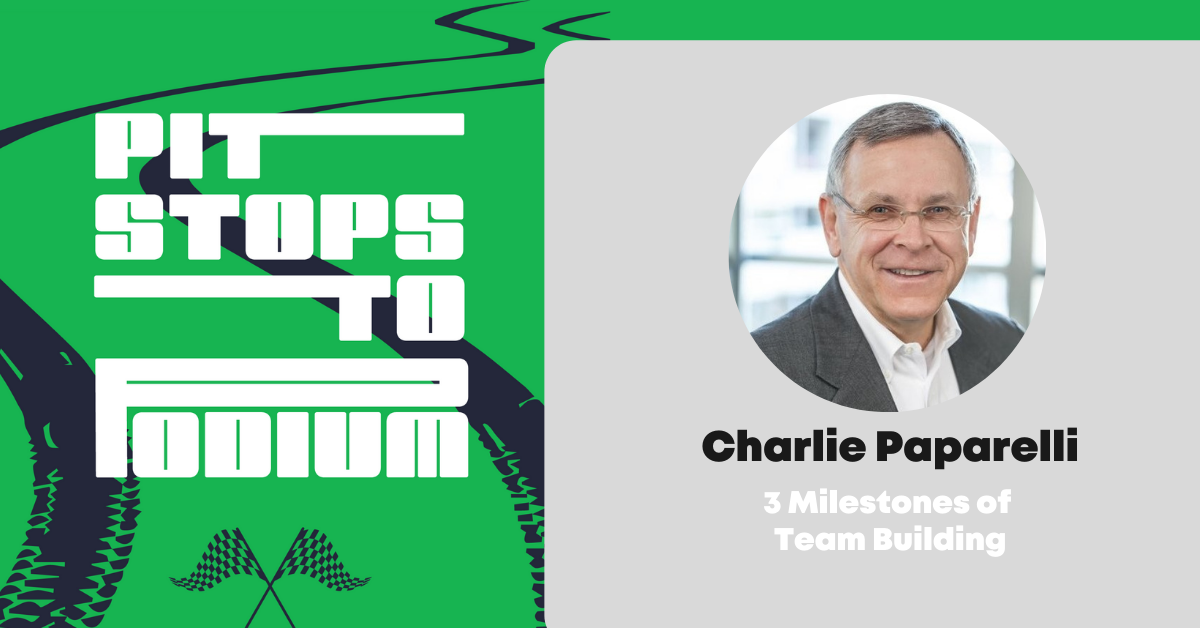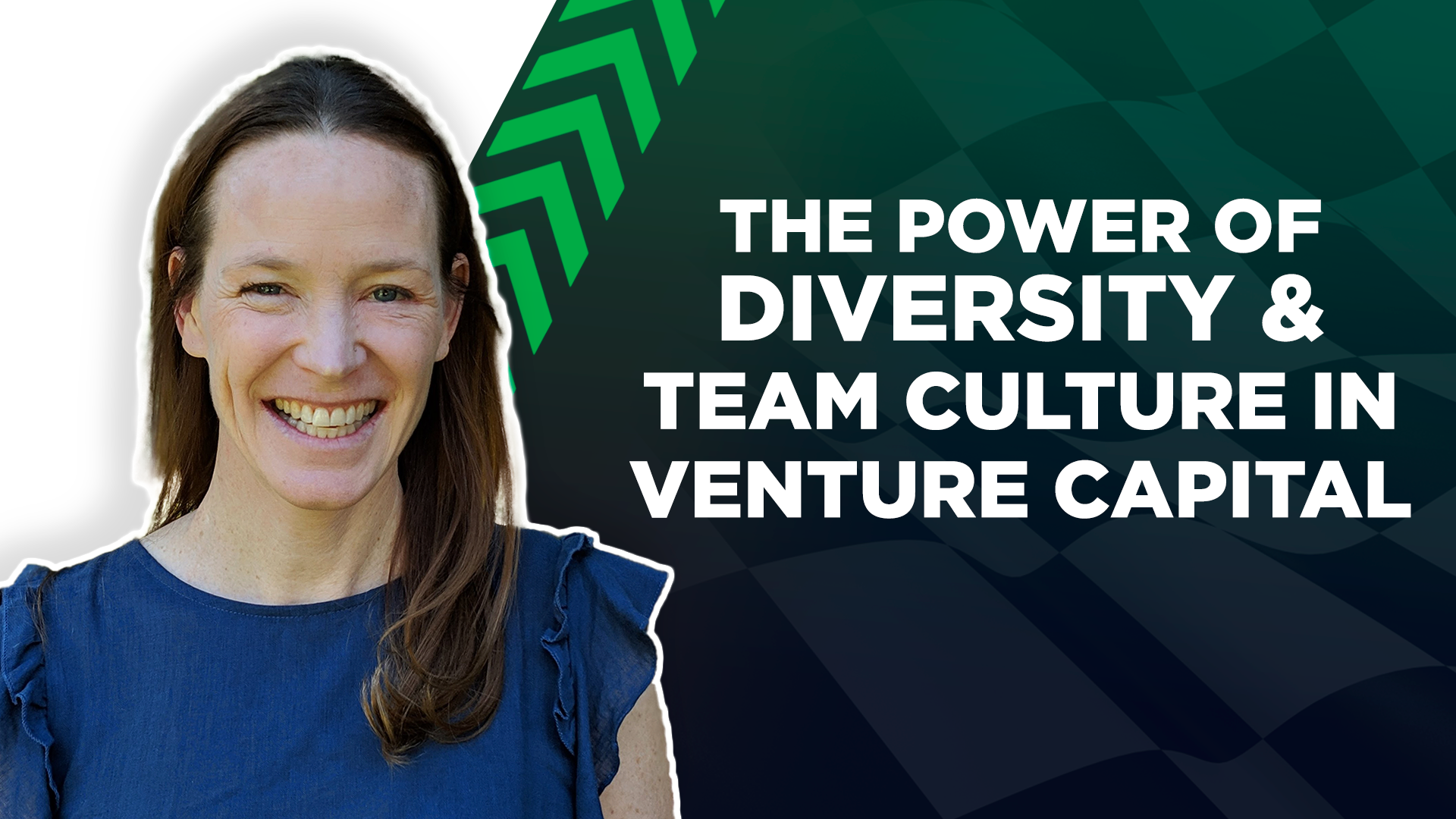Table of Contents
Key Metrics & Growth Signals From Investor’s Perspective
In episode 66 of Pit Stops to Podium, Brad Bentz discusses insights on the venture capital industry, key metrics and growth signals that investors look for in potential investments, and his advice for those looking to break into the world of startups and investing.
Co-Founder and Partner at ATX Partners, Brad is a seasoned investor with a proven track record of successful project management across several departments in multiple role functions. Brad's experience includes working at a boutique private equity firm where he participated in over a dozen transactions involving more than $72M in equity capital. More recently, he worked at IDC and Boston Consulting Group before joining the investment team at ATX Venture Partners.
If you’re ready to learn from one of the best, then buckle up and hold on!
Pitstop Highlights
Sustainable Growth
Sustainable growth = profitable growth. In the early stages, companies often grow quickly and therefore burn cash. When growth slows down, if a company is still generating a lot of cash, then it's a good indicator that the fundamentals of the business are strong and that the business is sustainable. This is in direct contrast to a business which grows at all costs, slows down, and then is still in the red.
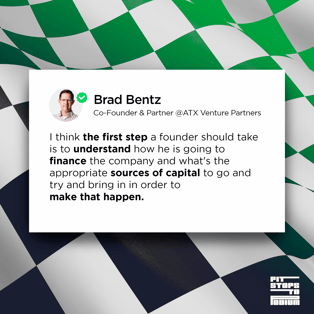
Insights into Growth Indicators as Perceived by Investors
Good growth signals for companies include strong gross margins and contribution margin. In these cases, with a little additional scale, these companies can generate enough revenue to cover fixed costs. Another reliable metric is CAC (customer acquisition cost) payback, where a good target is 18 months and under, and territory for concern is over 24 months. The last growth indicator is cash, where the primary considerations would be cash-on-hand, net monthly burn rate, and burn multiple.
"If you're starting out with high fixed costs and you have weak gross margins to begin with, then that puts you at a real disadvantage."
How Early Stage Companies Should Work Retention and Churn
This is often dependent on the type of customers a company is pursuing. For example, if you're going after SMB customers, then you're going to have some organic churn as a result of companies going out of business or cutting costs. Two goals to shoot for are gross revenue retention at 85% or higher and net revenue retention over 100%.
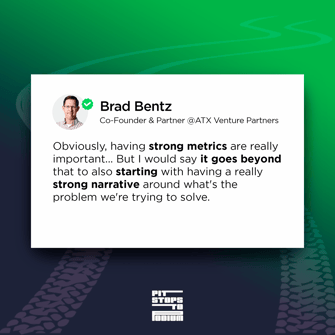
Connect with Brad
LinkedIn: https://www.linkedin.com/in/bradbentz/
Website: https://www.atxventurepartners.com/
Full Transcript
Brendan: Hey, everyone. Welcome to Pit Stops To Podium, the Rev Partners podcast, where we talk to execs who compete and won in taking their companies from high growth to high scale. My name is Brendan Tolleson. I serve as the co-founder and CEO of RevPartners and I'm delighted to have with me today Brad Bentz for this episode of Pit Stops to Podium. Welcome, Brad.
Brad: Thanks. I appreciate you having me.
Brendan: Yeah, absolutely. And so Brad, for the audience who may not know who you are, Brad's a co-founder and partnered ATX Venture Partners, and I can certainly give a background and explanation of who ATX is. However, I think it'd be better coming from you. So as our audience gets to know who you are in terms of what you do, I would love for you to give a little bit of background on who the firm is. And I also like to just understand the orchestra. So how did you come up with the idea to start the fund?
Brad: So, just for context, we're an early stage venture fund. We're based in Austin, but we do invest across North America. We've been around since 2014. And the origin story really goes back to my partner Chris Shank, who was an angel investor and an operator in Austin back 20 years ago, 20 plus years ago, and was co investing on a lot of early stage companies with a group of other venture backed founders in town. And then around the time that ATX was launched was when Austin Ventures decided that they were going to Sunset and they had been the 800 pound gorilla in our market for a long time. And so that left a big gaping hole in the market right as Austin was really starting to take off as an ecosystem. And so Chris and his co-founders decided that they wanted to put together some kind of a vehicle to be able to take advantage of the situation and help support early stage companies and founders in Austin who were doing great things. So that was kind of the genesis behind ATX Seed Ventures, which was kind of the predecessor or the precursor of ATX Venture Partners. So shortly after launching ATX Seed Ventures, Chris contacted me. I was at that time in the Boston area and he and I had both gone to the same MBA program together years earlier. And we had actually worked together at a company in Austin called Vertice before we kind of ended up going our separate paths. So I was working at that time at Boston Consulting Group in Boston itself and had also worked at IDC, which is an It research firm up in the Boston area. And so he said that he had just gotten ATX Venture off the ground, but could use some help or willing to move my family back to Austin. And I did that in 2015 and have been with the firm ever since. So we kind of rebranded after our first fund. Also a third co-founder joined Danielle Allen. And so we've been ATX Venture Partners ever since.
Brendan: That's great. And then fast forward today, how big is the fund and how much are you managing? What does it look like today?
Brad: Yeah, so we're investing out of our fourth fund currently, that's $125,000,000 vehicle. And I'd say across the four funds, we're probably managing about 300 million. But we actually have more than 300 million in SPVS that we manage. Altogether, we're talking probably five or 600 million firm wide.
Brendan: Congrats to you. I know that's not easy work, so you're clearly doing something right. And we'll get into a little bit, Brad, in terms of your kind of investment philosophy and some of the lessons you've learned in just a second. But before we do that, we do have a tradition here, and that's to get to know our guests outside of work. So what are some fun facts about Brad? And Brad, even as I was just doing some kind of background on you, you do have an unorthodox kind of background. So, I mean, I know you got your MBA and you work with BCG, among other things, but there's another wrinkle that I would love for you to share as one of your fun facts.
Brad: Sure. So my dark secret is I spent the first ten years of my career as a field archaeologist before I ever got into business, before I even got into technology. So that was kind of my first career path that I pursued back in the very common path for a VC. But I don't regret it. I mean, it was a great experience. Those are the kind of memories that stay with you for life. And, you know, it did kind of put me behind other people in my same age cohort in terms of our career development, because I was essentially coming into the business world 10-12 years after a lot of my peers. But again, I wouldn't trade it for anything.
Brendan: That's great. All right, so, archaeologist. What else?
Brad: I became a self taught software developer. So I did that for about six years before I decided to go to business school and really enjoyed it. And that's why I think Venture is a great fit for me because my first job outside after graduating from business school was to do real estate, private equity, which is certainly interesting, but not really as well suited to me, I think, coming from a software background as what I'm doing today. So Venture feels like a great fit for me.
Brendan: You've got a diverse background with archaeology, software development. What's the third thing you tell me that you have in your back pocket of things you can do?
Brad: I don't know if there's anything as earth shattering. I mean, these days it's a demanding job, so that takes a lot of my time. I have three kids, so between that and having a family, it doesn't leave a lot of time for interesting hobbies at this stage of my life.
Brendan: How old are your children?
Brad: The youngest is eleven and the oldest is 19, 16 year old as well.
Brendan: Okay, yeah, I've got three kids that are a little bit earlier so you can probably tell me some things what to do and what not to do. That's another podcast we can have.
Brad: I'll give you all the cautionary tales. I've made every mistake in the book.
Brendan: Yeah, well that's fun. Brad, thank you for sharing a little bit more about kind of just who you are. It's always fun just to get to know our guests outside of work. Well, let's transition to the big idea. Brad, we talked a little bit about what ATX is doing, the size of the fund. So clearly you have perspective. Look, this is an interesting time that we're currently living in. Even if you just see the headlines in terms of what's going on in tech, it's pretty volatile. And so there's a lot of talk about, hey, how do we transition away from scalable growth to sustainable growth? And so even just kind of thinking about what you do on a day in, day out basis with early stage companies, I think there's some fundamental growth signals metrics that I think a lot of our audience could really learn from. And so I'd love to focus on that topic with you because I think you have a unique perspective to it. Yeah, maybe before I give you a specific question, is there anything you want to speak into on that specific topic around scalable and sustainable that you think is important for our audience to have a little bit of context on how you define that?
Brad: Yeah, so when I think of sustainable growth, I'm thinking of profitable growth. Right? So a lot of companies are burning cash in their early years because they're growing quickly. But the idea is if you took your foot off the accelerator, would you start throwing off cash or would you still be burning cash? If you're generating a lot of cash as your growth slows down, that tells me that the fundamentals of the business are strong and that you've got a sustainable business that can persist for a very long period of time versus a company that's growing at all costs and is not paying attention to the unit economics. If that company slowed down, would it still be in the red? For me, that's kind of a litmus test when I'm looking at potential investment.
Brendan: I like that. I think it's probably a good segue into the first question I'd have for you is I think there's a balance there too, right? I mean, like in the early stage you do need to have that growth, right, so that you are able to get to a point of profitability. Some companies, yes, they're profitable from the very beginning, but there is an element of hey, we cash to continue to grow. So from your perspective as an investor, what are those kind of growth signals that you're looking for when you're considering, hey, is this a good fit for us or not?
Brad: Yeah. So first of all, some background. Most of the stuff that we work on, I would say our investments are heavily weighted towards SaaS software companies. And that's obviously not the only kind of business out there. I mean, there are also companies that have marketplace models that are more ecom driven and companies that have deal with physical goods and so forth. So my perspective is a little bit biased towards the type of SaaS companies that we spend most of our time with. But from that perspective, what I would first look for is strong gross margins and contribution margin. And to your point, at the very early stages when we're investing, typically we're investing kind of seed or series A level companies. There isn't enough revenue to cover the fixed costs. But what we're looking for are companies that have strong margins so that they could, with a little additional scale, get to a point where they can cover those quite handily. So if you're starting out with high fixed costs and you have weak gross margins to begin with, then that Puts you at a real disadvantage.
Brendan: Is there a certain margin that you are targeting when you think about GM?
Brad: So for SaaS companies I would say that the rule of thumb is kind of 70% or greater. Obviously the higher the better, but anything below 70% would kind of be a bit of a red flag for us in terms of is this really a SaaS business or is there something else going on? Obviously if you're a tech enabled service or something else, then the kind of margins that would apply to you would be different and we would take that into consideration. But if it's a typical SaaS based, I would be looking for really strong gross margins out of the gate on the contribution side.
Brendan: What does that look like for you guys?
Brad: Well, it kind of depends on how you're defining contribution margin. I think of it as the variable costs. Well, once you subtract the variable costs from revenue, what's left to cover the fixed costs in the company? And the variable costs can vary depending on the business. So that can include things like hosting and data costs associated with delivering a product can include implementation fees or onboarding costs. So I don't know that there's an easy rule of thumb, but I would say you probably would be looking for at least 25% or probably 50% contribution margin or greater would be a good starting point.
Brendan: That's great. Well, yeah, I think that gets into some of the margin side as we kind of look at some of other metrics that you care about as an investor when you're evaluating investment opportunities, when you think through could be growth rates or other areas. If there is hey ATX when they're making kind of these decisions. Here are the core metrics outside of even growth and contribution that you would say hey, whether it's a leading or lagging indicator, gives you confidence that this is a good opportunity for you.
Brad: Yeah. So I would include things like CAC payback. I'm not really a big fan of LTV CAC ratio because what I've found is that LTV there are a lot of different ways that you can calculate it and especially for earlier stage companies, you're dealing with a very small sample size. You have to make a lot of assumptions about how long someone's going to stay. If it's the first year of operations, you don't even have a full year to get to the renewal cycle for customer contracts. So there are too many assumptions baked in. But if you tell me that our CAC Payback is 18 months, for example, that's a much clearer picture of the kind of risk that we're taking in making an investment. And so we're looking for CAC Paybacks preferably below twelve months. But I would say that's kind of best in class, but certainly kind of 18 months and under is good. If it's more than 24 months, then that starts to get into what I would consider kind of a danger zone. Probably they're spending too much on customer acquisition.
Brendan: Yeah, it gets back to the maturity of the organization. To your point, and LTV deck seems to always be the one that people talk about, but to your point, hey, if I'm doing early stage, I don't have the longevity to have a true representation of LTV yet. Right, so that's a great one. Any other ones that you would be mindful of that our audience should be not careful of?
Brad: Yeah, well, we pay a lot of attention to cash at this stage of a company's life because cash is the lifeblood and you've got to manage it really well. So we would look at things like, obviously cash on hand, net monthly burn rate, and then burn multiple are really important. And burn multiple I think is interesting because it helps you understand what you're paying in order to achieve a unit of growth. How much additional investment are you having to make? Because the assumption is that you should be covering your existing customers are basically covering your operating expenses. So what you're spending beyond that, that's going to be the burn represents your efforts to grow your customer base. And so you want that multiple to be as low as possible. I would say certainly I would assume that companies are going to get more efficient at this over time, but I would say early on we're looking at hopefully burn multiples of three or less, and then as companies mature, we would expect that to get even lower.
Brendan: What's your advice for so you mentioned lifetime value at an early stage is not necessarily a good metric. I mean, not bad, it's just not really relevant. As relevant. Where does retention or churn, does that get into the cash side or how do you think through what's your advice for earlier stage companies? At the beginning, it is irrelevant because they're not around long enough. But how should they be thinking about the retention side or churn?
Brad: Yeah, well, I mean, investors are definitely going to be interested in customer retention and churn. It does depend a little bit on the type of customers you're going after. So, for example, if you're going after SMB customers, you're probably going to have organic churn from just companies going out of business or in financial stress and they're having to cut costs. So there's a little bit of an allowance that we make for companies that are selling to true SMB market versus those that are doing more mid market enterprise. But obviously you want to see churn to be as low as possible. And so we look at gross and net revenue retention as key metrics when we're making investments. You want to see gross revenue retention, preferably 85% or higher, and then net revenue retention, ideally over 100%, which is kind of a leading indicator of people's propensity to buy more of the product if you've got a stronger net revenue retention number than your GRR.
Brendan: Yeah, well, I appreciate the insights there, Brad. I think it kind of is a good both those culminated into kind of the next question. We talk a little bit about the uncertainty in the market right now, but there's still a need to innovate, there's still a need for software, and there's capital candidly to be deployed. So when we think about tips or recommendations for those entrepreneurs, those founders that are looking to raise this year, what would be your advice to them as they think through the best way to approach the upcoming raise?
Brad: So obviously, having strong metrics are really important and that's kind of the topic du jour that we're discussing right now. But I would say it goes beyond that to also starting with having a really strong narrative around what's the problem we're trying to solve. Is it a problem that's worth solving? Is the market compelling enough to attract venture type capital? Because it's a very high cost of capital relative to other sources. And so it's really only suitable for a minority of companies that are trying to address a really large and fast growing market that doesn't have a really strong incumbent already in it. So those are really the kinds of opportunities that we're focused on. And so if I'm a founder and I'm trying to raise money in this market, I would kind of start there in terms of my deck is having a really strong narrative around why this is a problem that genuinely needs to be solved and there's no adequate solution out there. And why is this the best team to go and do that? And why do we think we can build a category leading company in a very large, fast growing market? I think those are the things that kind of get investors at in a more emotional level. Those are the more qualitative aspects. And then you want to have the KPIs to kind of back it up to say, well, here's a TAM, here's our growth rate, here's our burn. We can show how there's a plausible path if we take in this money, that we can deploy it and get to that next inflection point and be able to raise money at a much better valuation.
Brendan: Yeah, I like that advice. And one of the things that really struck me that you mentioned, it's a bit of a cautionary tale too, to that entrepreneur kind of understanding, hey, is the juice really worth the squeeze? Meaning do I really want to raise this money right now? It's not mean you shouldn't. It's just making sure that you understand to your point, hey, what is truly the opportunity here? And does it allow me to maximize that and accelerate it? Because if not, there are other ways to access capital for that. I appreciate that.
Brad: Yeah. If you look at how companies are financed. Venture capital is really a small percentage of how most companies get their funds. It's a good fit for some kind of companies, And it's a bad fit for others. So I think the first step a founder should take is to understand how am I going to finance the company and what's the appropriate sources of capital to go and try and bring in in order to make that happen. You see a lot of founders that are just trying to tilt at windmills, sending decks to VCs when they're never going to get an investment. And it's nothing it's nothing wrong with their business per se. It's just that they've been kind of seduced by all the talk about founders getting billion dollar valuations and 100 billion dollar rounds, and everybody has stars in their eyes and thinks, well, that's the way to go and raise money if I'm going to start a company. And it makes sense for some types of businesses but not others. And I just want people to be aware of that before they go down that path.
Brendan: I think that transparency is kindness, so I appreciate you kind of giving that perspective. Well, Brad, as we wrap up, as kind of a final lap question, if our audience wants to engage with your firm or to engage with you, what's the next step they can take?
Brad: So you can reach out to me on LinkedIn, you can reach out to our firm. We have our website atxventurepartners.com personally, I think the best way to reach out to any VC, whether it's me or anybody else, is to find someone that they know and trust and get a warm introduction through them. And I know it's not easy, but we get bombarded. I probably get 10-15 decks per day that hit my inbox. And between everything else that I have going on, I just don't have time to give everyone a thoughtful review and then compose a response. So a lot of times it can look like it's going to a black hole. So if you can use LinkedIn to find somebody who knows somebody who can make an introduction, that's going to be a far more likely path to have a real conversation with the VC than just shooting them a deck via email.
Brendan: That or you're an archaeologist in your past and you have a connection with Brad. Maybe they'll cut through the noise. Well, Brad, thank you for coming on board. Especially in this kind of climate, it's really helpful to make sure we're aligned on those fundamentals of metrics to be monitoring and to make sure you understand if it's worth it or not. So really appreciate your perspective and your insights, and thanks for coming on board.
Brad: Yeah, it was a pleasure.
Brendan: All right, talk to you later. Thanks.
Want to learn from more industry experts?
Come check out the full Pit Stops to Podium podcast repository!
